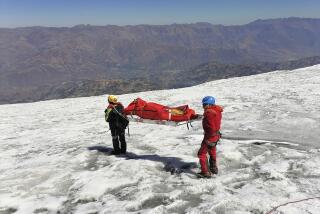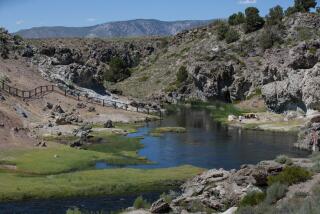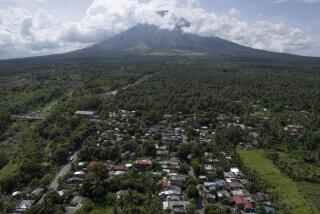Images Haunt Survivors of Volcano Eruption : Disaster: On what had seemed a routine exploration, U.N. scientists are caught in surprise explosion that killed nine and injured 10.
- Share via
When the United Nations team of 70 scientists ventured into Colombia’s 13,680-foot Galeras volcano, it seemed safe enough. The volcano had not erupted in six months, and instruments detected no seismic warning signs.
But at 1:40 p.m. Jan. 14, Galeras began to belch ash and steam and spew glowing rocks a meter or more in diameter. Caught inside the volcano’s crater, nine scientists died and 10 others--including an Arizona scientist who led the U.S. contingent--were injured.
Those who survived credited quick action by rescuers--including two Colombian scientists who braved the eruption and entered the crater--and luck for making it out alive.
“I guess what really strikes me the most is fate,” said Christopher Sanders of Arizona State University, one of 15 Americans on the team. “Had it happened an hour earlier, it would have killed everybody because we were all right down in the mouth of the inner crater.”
As eruptions go, “it was a small event,” said Chuck Connor of the Southwest Research Institute of San Antonio. But from inside the volcano, the eruption was terrifying.
The scientists were investigating Galeras as part of a decade-long U.N. project studying how to reduce the hazards from dangerous volcanoes. Galeras qualifies because 300,000 people live downslope from the volcano in the town of Pasto and could be threatened by a major eruption.
A Russian, a Briton and seven Colombians lost their lives. Four Americans were injured. Stanley Williams, an Arizona State geologist who led the American part of the expedition, faces a yearlong recovery from injuries.
Williams, 40, suffered a fractured skull, nose and jaw, and broken legs when he was hit by debris while trying to make his way out of the inner cone. Colleagues say he would not have survived but for the two scientists who descended from the summit of the outer rim while the volcano was erupting.
The women--including Marta Calvache, acting director of the Pasto volcanic observatory--found Williams and hauled him on a stretcher several hundred feet up to safety.
Andrew McFarlane, a geologist from Florida International University in Miami, recalled the scene inside the crater before undergoing plastic surgery last week for a gash in his head. He said the scientists had just completed their work for the day.
“We had decided to leave,” McFarlane said. “Of our group of nine, four were killed on the way out.”
The group was descending a cone leading away from the active inner crater “and we heard a loud boom. At first I don’t think it was instantly clear to everyone what was happening. It was not ear-shattering. But I looked back up on top and there was a dark cloud, and someone--I think it was Stan (Williams)--said: ‘It’s the volcano!’ And we started running.”
Running was difficult, he said: “The surface is a mixture of soft ash and big boulders. Blocks of hot rock were falling. I have a lot of frantic memories of running and falling and getting up and falling. The blocks were up to a meter across. I saw a man hit by one of them.”
Michael Conway, a doctorate candidate from Michigan Tech, recalled: “There was suddenly a blast, just an explosion, and we all started running down the slope. . . . I took one hit in the head, but it was a rather small piece, a lot of bleeding but that was it.
“We lost track of one another during the first two or three minutes when the eruption was greatest,” he said. “But then we got behind some rocks and pulled our packs over our heads and tried to out-wait the worst of the eruption, so I didn’t see anybody else get struck by anything. We saw some dead Colombian scientists on the way down.”
About 45 minutes later, as Williams and the others shouted for help, aid arrived in the form of Calvache and Patricia A. Mothes, of the National Geophysical Institute of Ecuador. They had been driving on a road near the summit when they observed the eruption.
“They courageously came into the caldera an hour or more before any of the other rescuers,” Conway said. “They got Luis la Marie, an Ecuadorean, out. He was badly hurt--two broken legs, a broken clavicle, several broken fingers and a minor cut across his forehead.
“And they got Stanley out to a helicopter on the rim, which was very fortunate. Without the helicopter getting him to a hospital quickly, I think he would have had a very hard time surviving.”
Reached by telephone at the Pasto observatory, Calvache was modest about her role in the rescue.
“Other people helped,” she said. “At the end, we had the driver and some of the field assistants. A policeman came down the rope. We had a helicopter, but it was on the summit. It was very difficult to take (the injured) from the lower part of the outer crater to the summit.”
Only ash and a few small rocks were falling by the time she and Mothes launched the rescue, Calvache said.
“We had managed to get to the bottom of the cone,” McFarlane said. “We were staggering up this outer caldera wall. I was going a few steps and then collapsing, and in between I was yelling for help. I’m not really sure how much time went by, 45 minutes or an hour, but Marta and her companion got down there.
“The column of ash was still erupting. They were scared too, but they managed to give me some water. Between the two of them, they tried to help me walk, but I only got another 10 meters before I collapsed. And then there were more rescuers. They had a metal stretcher and they pulled me out.”
Among those killed were Geoff Brown of the Open University of Britain and Igor Menyaylov of Russia’s Kamchatka Volcanic Institute. One of McFarlane’s haunting memories is Menyaylov relaxing at the bottom of the inner crater just minutes before the eruption.
“He felt no menace at all,” McFarlane said. “He was having a good time. I’m sure he was killed before he knew what had happened.”
Calvache said that the Galeras volcano had last erupted July 16 and that since 1989 there had been a number of minor eruptions. In this century, the volcano also erupted with lava flows in 1936 and 1945.
Pasto is only six miles downhill from the rim, at an elevation of about 9,000 feet, and there has been dissension between town leaders and the observatory directors over any hazard the volcano might pose.
Calvache said studies indicate that pyroclastic material (hot rocks and gases) have, over thousands of years, repeatedly hit the outskirts of Pasto, but not in this century. But a major eruption that overflowed the outer rim could threaten the city, as well as other cities nearby, she said.
When the scientists arrived in Pasto on Jan. 11, there was nothing in the briefings that suggested even a minor eruption was imminent.
Connor said that Steve McNutt, from the Alaskan Volcanic Observatory in Fairbanks, reviewed the record of seismic instruments he had carried and found no earthquakes of even tiny magnitude at Galeras before the eruption.
Three U.S. Geological Survey scientists were blocked from going to Pasto by the State Department because of the U.S. Embassy in Bogota’s concerns that guerrilla activity in the area might jeopardize their safety. The Americans who participated in the expedition were not federal employees.
“It was lucky,” said Dan Miller of the Geological Survey’s volcanic observatory near Mt. St. Helens in Washington state. “Fate has unusual ways of doing things sometimes, and I’m certainly not unhappy about this one.”
Volcano Tragedy
Scientists in Colombia as part of a United Nations project to study the 13,680-foot Galeras volcano were caught in a surprise eruption Jan. 14. Nine people were killed.
1. A British citizen and two Colombians, disappeared at fumaroles on the west side of the inner crater rim.
2. A Russian and a Colombian were last seen at the bottom of the crater.
3. Four Colombians died and several Americans were injured by red-hot rocks as they ran down the east side of the cone.
4. Rescuers from the police station used ropes to descend from the outer rim to carry the injured to safety. Pasto, population 300,000, is only six miles from the summit.
More to Read
Sign up for Essential California
The most important California stories and recommendations in your inbox every morning.
You may occasionally receive promotional content from the Los Angeles Times.










